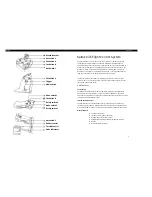
Omega Model CYD211 User’s Manual
2-6 Installation
2.5.5 Sensor
Polarity
Omega sensors ship with instructions that indicate which sensor leads are
which. It is important to follow these instructions for plus and minus leads
(polarity) as well as voltage and current when applicable. Diode sensors do
not operate in the wrong polarity. They look like an open circuit to the
instrument. Two-lead resistors can operate with any lead arrangement and
the sensor instructions may not specify polarity. Four-lead resistors may
depend more on lead arrangement. Follow any specified lead assignment for
four lead resistors. Mixing leads could give a reading that appears correct,
but is not the most accurate.
DT-670-SD
Diode Sensor Leads
Anode
Cathode
2.5.6 Four-Lead
Sensor
Measurement
All sensors, including both two-lead and four-lead can be measured with a
four-lead technique. Four-lead measurement eliminates the effect of lead
resistance on the measurement. If it is not taken out, lead resistance is a
direct error when measuring a sensor.
I+
V+
I
V
Four-Lead
Diode
Four-Lead
Platinum
I+
V+
I
V
In a four lead measurement, current leads and voltage leads run separately
to the sensor. With separate leads, there is little current in the voltage leads
so their resistance does not enter into the measurement. Resistance in the
current leads will not change the current as long as the voltage compliance
of the current source is not reached. When two lead sensors are used in four
lead measurements, the short leads on the sensor have an insignificant
resistance.















































